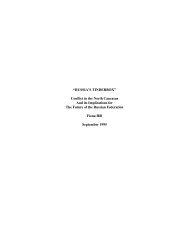Global Environmental Assessment Project - Belfer Center for ...
Global Environmental Assessment Project - Belfer Center for ...
Global Environmental Assessment Project - Belfer Center for ...
Create successful ePaper yourself
Turn your PDF publications into a flip-book with our unique Google optimized e-Paper software.
The U.S. Man in the Biosphere Program funded Phase 1, while the U.S. Geological Survey and the U.S.<br />
Army Corps of Engineers were the primary funders <strong>for</strong> Phase 2. Since these agencies provided financial<br />
support through a grant proposal process, they had little vested interest in SSD results, and were<br />
there<strong>for</strong>e not interviewed <strong>for</strong> this study. Additional funds came from the Metropolitan Water District of<br />
Southern Cali<strong>for</strong>nia, the Upper Colorado River Basin Commission, and Water Resource Institutes at the<br />
University of Arizona, University of Cali<strong>for</strong>nia, Colorado State University, Utah State University, and<br />
the University of Wyoming (Young, 1995). Many of these organizations were represented as SSD<br />
principal investigators or members of the AC, and were amongst the people interviewed.<br />
Phase 1 and Phase 2 of the SSD assessment were the primary documents used <strong>for</strong> background<br />
in<strong>for</strong>mation on study results and recommendations. Additional written materials covering historical<br />
documentation of the Law of the River, environmental controversies in the Colorado Basin, Bureau of<br />
Reclamation reservoir operating criteria and hydrological data, impacts of interannual climate<br />
variability on Colorado River flow, and the websites of multiple organizations in the Basin were<br />
essential to <strong>for</strong>mulating interview questions and providing the historical, legal, and political context of<br />
water allocation in the Colorado Basin.<br />
Results & Discussion<br />
<strong>Environmental</strong> assessments can be evaluated both in terms of their effects and their effectiveness.<br />
Effects cover the entire range of consequences of an assessment, regardless of original intent, whereas<br />
evaluation of effectiveness is directly related to the intent of the designers and participants in an<br />
assessment process. For the purposes of this study, I define effectiveness as the degree to which each of<br />
the following three outcomes occurred (listed with increasing impact on water management and policy<br />
in the Colorado Basin):<br />
1) water managers' framing of extreme drought changed from one based solely on historical<br />
experience to one that includes an extreme event from the paleoclimatic record;<br />
2) methods by which drought risk is determined and included in the long-range management of<br />
Colorado Basin reservoirs were expanded to include tree-ring reconstructions of river flow; and<br />
3) a diverse set of water allocation policies (along the lines of those suggested by the SSD) were<br />
created to better cope with the impacts of long-term drought on a basin-wide scale.<br />
Almost without exception, interviewees found that the SSD changed their perception of extreme<br />
drought in the Colorado Basin. Many of the AC. members, while aware of tree-ring-based drought<br />
reconstructions, were not cognizant of the impacts such a drought would have on modem water uses. In<br />
this limited sense, the SSD achieved the first measure of effectiveness listed above - several water<br />
managers came out the assessment process with an expanded perception of the potential impacts of<br />
severe drought.<br />
While awareness of pre-historic droughts increased as a result of the SSD study, this appears to have<br />
had little impact on Colorado River water management and policy. As discussed in the drought risk<br />
section, the Long-Range Operating Criteria <strong>for</strong> Colorado Basin reservoirs utilize a historical critical<br />
flow period (1952-64) <strong>for</strong> long-range supply projections, as opposed to the more severe late 16 th -century<br />
event. Interviews with Bureau of Reclamation officials indicate this is due primarily to bureaucratic<br />
inertia and the politically-sensitive nature of using a more dire drought event. After using the same<br />
critical flow<br />
6
















